HTML
--> --> -->The neutrinos in the SM have hot dark matter characteristics, but the large scale structure of the universe supports the idea that cold dark matter is dominant. Therefore, the SM cannot provide a cold dark matter candidate. Although the SM has achieved great success with the detection of the 125 GeV Higgs boson, it has some shortcomings, such as the hierarchy problem, CP-violating problem, and neutrino with zero mass. Therefore, we consider extending the SM; the MSSM [3-5] is one choice of many supersymmetric models. However, the MSSM still fails to explain neutrino oscillation experiments, and its reasonable parameter space constrained by the experiments becomes increasingly smaller. Therefore, we need to expand the MSSM.
The BLMSSM [6-9] is an extension of the MSSM with local gauged B and L, whose local gauge group is
In current dark matter research, there are many dark matter candidates. They include massive compact halo objects (MACHOs) [10-12], primordial black holes, neutrinos, axions, and weakly-interacting massive particles (WIMPs) [13-17]. They all satisfy or partially satisfy the following conditions: no electric charge and no color charge, remaining stable, and possessing a long life [18, 19]. These characteristics could explain the observed large scale structure of the universe. Thus, cold dark matter is favored.
In the MSSM, the scalar neutrinos are only left-handed and interact with gauge bosons at tree level. This model cannot satisfy the constraints present from the relic density or direct detection experiments because of the large cross section. The introduced right-handed neutrinos are inactive and stable. The sneutrinos are electric and color neutral. If the lightest mass eigenstate of the sneutrino mass squared matrix is the lightest supersymmetric particle (LSP), and its dominant element is the right-handed sneutrino, it will be a good dark matter candidate. The reason is that it can easily satisfy the experimental restrictions from dark matter direct detection and give reasonable relic density. Eventually, the lightest scalar neutrino is adopted as a candidate for dark matter in this paper. There are other studies of sneutrino dark matter in extensions of the MSSM [20-27].
After this introduction, we show the main contents of the BLMSSM in section II. Sections III and IV are devoted to the equations of relic density and direct detection. We calculate the numerical results and find a reasonable parameter space in the BLMSSM in section V. The discussion and conclusion are provided in section VI.
| superfields |   |   |   |   |   |
  | 3 | 2 | 1/6 | 1/3 | 0 |
  |   | 1 | ?2/3 | ?1/3 | 0 |
  |   | 1 | 1/3 | ?1/3 | 0 |
  | 1 | 2 | ?1/2 | 0 | 1 |
  | 1 | 1 | 1 | 0 | ?1 |
  | 1 | 1 | 0 | 0 | ?1 |
  | 3 | 2 | 1/6 |   | 0 |
  |   | 1 | ?2/3 |   | 0 |
  |   | 1 | 1/3 |   | 0 |
  | 1 | 2 | ?1/2 | 0 |   |
  | 1 | 1 | 1 | 0 |   |
  | 1 | 1 | 0 | 0 |   |
  |   | 2 | ?1/6 |   | 0 |
  | 3 | 1 | 2/3 |   | 0 |
  | 3 | 1 | ?1/3 |   | 0 |
  | 1 | 2 | 1/2 | 0 |   |
  | 1 | 1 | ?1 | 0 |   |
  | 1 | 1 | 0 | 0 |   |
  | 1 | 2 | 1/2 | 0 | 0 |
  | 1 | 2 | ?1/2 | 0 | 0 |
  | 1 | 1 | 0 | 1 | 0 |
  | 1 | 1 | 0 | ?1 | 0 |
  | 1 | 1 | 0 | 0 | ?2 |
  | 1 | 1 | 0 | 0 | 2 |
  | 1 | 1 | 0 |   | 0 |
  | 1 | 1 | 0 |   | 0 |
Table1.Superfields in the BLMSSM.
After the Higgs obtain VEVs, the local gauge symmetry
$\begin{aligned}[b]&H_{u} \!=\! \left(\!\!\!\!\!\begin{array}{c}H_{u}^+\\{\dfrac{1}{\sqrt{2}}}\Big(\upsilon_{u}\!+\!H_{u}^0\!+\!{\rm i}P_{u}^0\Big)\end{array}\!\!\!\!\!\right)\;,\; H_{d} \!=\! \left(\!\!\!\!\!\begin{array}{c}{\dfrac{1}{\sqrt{2}}}\Big(\upsilon_{d}\!+\!H_{d}^0\!+\!{\rm i}P_{d}^0\Big)\\H_{d}^-\end{array}\!\!\!\!\!\right)\;, \\ &\Phi_{B} = {1\over\sqrt{2}}\Big(\upsilon_{B}+\Phi_{B}^0+{\rm i}P_{B}^0\Big)\;,\;\; \varphi_{B} = {1\over\sqrt{2}}\Big(\overline{\upsilon}_{B}+\varphi_{B}^0+{\rm i}\overline{P}_{B}^0\Big)\;, \\&\Phi_{L} = {1\over\sqrt{2}}\Big(\upsilon_{L}+\Phi_{L}^0+{\rm i}P_{L}^0\Big)\;,\;\;\varphi_{L} = {1\over\sqrt{2}}\Big(\overline{\upsilon}_{L}+\varphi_{L}^0+{\rm i}\overline{P}_{L}^0\Big)\;. \end{aligned}$  | (1) |
$ \begin{aligned}[b]{\cal W}_{{\rm BLMSSM}} \!=& {\cal W}_{{\rm MSSM}}+{\cal W}_{B}+{\cal W}_{L}+{\cal W}_{X}\;, \\{\cal W}_{B} \!=& \lambda_{Q}\hat{Q}_{4}\hat{Q}_{5}^c\hat{\Phi}_{B}+\lambda_{U}\hat{U}_{4}^c\hat{U}_{5} \hat{\varphi}_{B}+\lambda_{D}\hat{D}_{4}^c\hat{D}_{5}\hat{\varphi}_{B}\\ &+\mu_{B}\hat{\Phi}_{B}\hat{\varphi}_{B} +Y_{{u_4}}\hat{Q}_{4}\hat{H}_{u}\hat{U}_{4}^c+Y_{{d_4}}\hat{Q}_{4}\hat{H}_{d}\hat{D}_{4}^c \\&+Y_{{u_5}}\hat{Q}_{5}^c\hat{H}_{d}\hat{U}_{5}+Y_{{d_5}}\hat{Q}_{5}^c\hat{H}_{u}\hat{D}_{5}\;, \\ {\cal W}_{L} \!=& Y_{{e_4}}\hat{L}_{4}\hat{H}_{d}\hat{E}_{4}^c+Y_{{\nu_4}}\hat{L}_{4}\hat{H}_{u}\hat{N}_{4}^c +Y_{{e_5}}\hat{L}_{5}^c\hat{H}_{u}\hat{E}_{5}\\&+\!Y_{{\nu_5}}\hat{L}_{5}^c\hat{H}_{d}\hat{N}_{5} \!+\!Y_{\nu}\hat{L}\hat{H}_{u}\hat{N}^c\!+\!\lambda_{{N^c}}\hat{N}^c\hat{N}^c\hat{\varphi}_{L} \!+\!\mu_{L}\hat{\Phi}_{L}\hat{\varphi}_{L}, \\{\cal W}_{X} \!=& \lambda_1\hat{Q}\hat{Q}_{5}^c\hat{X}+\lambda_2\hat{U}^c\hat{U}_{5}\hat{X}^\prime +\lambda_3\hat{D}^c\hat{D}_{5}\hat{X}^\prime+\mu_{X}\hat{X}\hat{X}^\prime\;,\end{aligned} $  | (2) |
$ \begin{aligned}[b]{\cal L}_{{\rm soft}} =& {\cal L}_{{\rm soft}}^{\rm MSSM}-(m_{{\tilde{N}^c}}^2)_{{IJ}}\tilde{N}_I^{c*}\tilde{N}_J^c -m_{{\tilde{Q}_4}}^2\tilde{Q}_{4}^\dagger\tilde{Q}_{4}-m_{{\tilde{U}_4}}^2\tilde{U}_{4}^{c*}\tilde{U}_{4}^c \\&-m_{{\tilde{D}_4}}^2\tilde{D}_{4}^{c*}\tilde{D}_{4}^c -m_{{\tilde{Q}_5}}^2\tilde{Q}_{5}^{c\dagger}\tilde{Q}_{5}^c-m_{{\tilde{U}_5}}^2\tilde{U}_{5}^*\tilde{U}_{5} -m_{{\tilde{D}_5}}^2\tilde{D}_{5}^*\tilde{D}_{5}\\&-m_{{\tilde{L}_4}}^2\tilde{L}_{4}^\dagger\tilde{L}_{4}-m_{{\tilde{\nu}_4}}^2\tilde{N}_{4}^{c*}\tilde{N}_{4}^c -m_{{\tilde{e}_4}}^2\tilde{E}_{_4}^{c*}\tilde{E}_{4}^c-m_{{\tilde{L}_5}}^2\tilde{L}_{5}^{c\dagger}\tilde{L}_{5}^c \\&-m_{{\tilde{\nu}_5}}^2\tilde{N}_{5}^*\tilde{N}_{5}-m_{{\tilde{e}_5}}^2\tilde{E}_{5}^*\tilde{E}_{5} -m_{{\Phi_{B}}}^2\Phi_{B}^*\Phi_{B} -m_{{\varphi_{B}}}^2\varphi_{B}^*\varphi_{B}\\ &-m_{{\Phi_{L}}}^2\Phi_{L}^*\Phi_{L} -m_{{\varphi_{L}}}^2\varphi_{L}^*\varphi_{L}-\Big(m_{B}\lambda_{B}\lambda_{B} +m_{L}\lambda_{L}\lambda_{L}+{\rm h.c.}\Big) \\ &+\Big\{A_{{u_4}}Y_{{u_4}}\tilde{Q}_{4}H_{u}\tilde{U}_{4}^c+A_{{d_4}}Y_{{d_4}}\tilde{Q}_{4}H_{d}\tilde{D}_{4}^c +A_{{u_5}}Y_{{u_5}}\tilde{Q}_{5}^cH_{d}\tilde{U}_{5} \\ &+A_{{d_5}}Y_{{d_5}}\tilde{Q}_{5}^cH_{u}\tilde{D}_{5}+A_{{BQ}}\lambda_{Q}\tilde{Q}_{4}\tilde{Q}_{5}^c\Phi_{B}+A_{{BU}}\lambda_{U}\tilde{U}_{4}^c\tilde{U}_{5}\varphi_{B} \\&+A_{{BD}}\lambda_{D}\tilde{D}_{4}^c\tilde{D}_{5}\varphi_{B}+B_{B}\mu_{B}\Phi_{B}\varphi_{B} +{\rm h.c.}\Big\} \\ &+\Big\{A_{{e_4}}Y_{{e_4}}\tilde{L}_{4}H_{d}\tilde{E}_{4}^c+A_{{\nu_4}}Y_{{\nu_4}}\tilde{L}_{4}H_{u}\tilde{N}_{4}^c +A_{{e_5}}Y_{{e_5}}\tilde{L}_{5}^cH_{u}\tilde{E}_{5}\\ &+A_{{\nu_5}}Y_{{\nu_5}}\tilde{L}_{5}^cH_{d}\tilde{N}_{5} +A_{N}Y_{\nu}\tilde{L}H_{u}\tilde{N}^c+A_{{N^c}}\lambda_{{N^c}}\tilde{N}^c\tilde{N}^c\varphi_{L} \\&+B_{L}\mu_{L}\Phi_{L}\varphi_{L}+{\rm h.c.}\Big\} +\Big\{A_1\lambda_1\tilde{Q}\tilde{Q}_{5}^cX+A_2\lambda_2\tilde{U}^c\tilde{U}_{5}X^\prime \\&+A_3\lambda_3\tilde{D}^c\tilde{D}_{5}X^\prime+B_{X}\mu_{X}XX^\prime+{\rm h.c.}\Big\}\;. \end{aligned} $  | (3) |
The elements of the mass squared matrix of a sneutrino read as [ 9]
$ \begin{aligned}[b]M_{\tilde n}^2(\tilde\nu_I^* \tilde\nu_J) \!=& \frac{g_1^2+g_2^2}{8}(v_d^2-v_u^2)\delta_{IJ}+g_L^2(\bar{v}_L^2-v_L^2)\delta_{IJ}\\&+\frac{v_u^2}{2}(Y_\nu^{\dagger} Y_\nu)_{IJ}+(m_{\tilde L}^2)_{IJ}, \\M_{\tilde n}^2(\tilde N_I ^{c*} \tilde N _J ^c) \!=& -g_L^2(\bar{v}_L^2-v_L^2)\delta_{IJ}+\frac{v_u^2}{2}(Y_\nu^{\dagger} Y_\nu)_{IJ}+2\bar{v}_L^2({\lambda}_{N^c}^{\dagger} {\lambda}_{N^c})_{IJ} \\&+(m_{\tilde N^c} ^2)_{IJ}+{\mu}_L\frac{v_L}{\sqrt 2}(\lambda_{N^c})_{IJ}-\frac{\bar v _L}{\sqrt 2}(A_{N^c})_{IJ}({\lambda}_{N^c})_{IJ}, \\ M_{\tilde n}^2(\tilde\nu_I \tilde N_J^c) \!= &{\mu}^* \frac{v_d}{\sqrt 2}(Y_\nu)_{IJ}\!-\!v_u \bar v_L(Y_\nu^{\dagger}\lambda_{N^c})_{IJ}\!+\!\frac{v_u}{\sqrt 2}(A_N)_{IJ}(Y_\nu)_{IJ}.\end{aligned} $  | (4) |
With the introduced superfields
$ \begin{aligned}[b]&Z_{N_{\nu}}^\top\left(\begin{array}{cc} 0&\dfrac{v_u}{\sqrt{2}}(Y_{\nu})^{IJ} \\ \dfrac{v_u}{\sqrt{2}}(Y^{T}_{\nu})^{IJ} & \dfrac{\bar{v}_L}{\sqrt{2}}(\lambda_{N^c})^{IJ} \end{array}\right)Z_{N_{\nu}} = {\rm diag}(m_{\nu^{\alpha}}), \\&\alpha = 1\cdots 6,I,J = 1,2,3, \\ &\psi_{{\nu_L^I}} = Z_{{N_{\nu}}}^{I\alpha}k_{N_\alpha}^0,\;\;\;\; \psi_{N_R^{cI}} = Z_{{N_{\nu}}}^{(I+3)\alpha}k_{N_\alpha}^0,\;\;\;\; \chi_{N_\alpha}^0 = \left(\begin{array}{c} k_{N_\alpha}^0\\ \bar{k}_{N_\alpha}^0 \end{array}\right),\end{aligned} $  | (5) |
In the BLMSSM, the mass squared matrix of the slepton reads as
$ \left(\begin{array}{cc}({\cal M}^2_L)_{LL}&({\cal M}^2_L)_{LR}\\({\cal M}^2_L)^\dagger_{LR}&({\cal M}^2_L)_{RR}\end{array}\right). $  | (6) |
$ \begin{aligned}[b] ({\cal M}^2_L)_{LL} =& \frac{(g^2_1-g^2_2)(v^2_d-v^2_u)}{8} \delta_{IJ}+g^2_L(\bar{v}^2_L-v^2_L)\delta_{IJ}\\ &+{m^2_{l^I}}\delta_{IJ}+(m^2_{\bar{L}})_{IJ}, \\ ({\cal M}^2_L)_{LR} = &{\mu^\ast v_u\over\sqrt{2}}(Y_l)_{IJ}-{v_u\over\sqrt{2}}(A'_l)_{IJ}+{v_d\over\sqrt{2}}(A_l)_{IJ}, \\ ({\cal M}^2_L)_{RR} =&{g^2_1(v^2_u-v^2_d)\over4}\delta_{IJ}-g^2_L(\bar{v}^2_L-v^2_L)\delta_{IJ}+m^2_{l^I}\delta_{IJ}+(m^2_{\tilde{R}})_{IJ}.\end{aligned} $  | (7) |
Some couplings are shown here. The couplings of the W-lepton-neutrino and Z-neutrino-neutrino are different from those in the MSSM, and their concrete forms are
$ \begin{aligned}[b]&{\cal L}_{Wl\nu} = -\frac{e}{\sqrt{2}s_W}W_{\mu}^+\sum\limits_{I = 1}^3\sum\limits_{\alpha = 1}^6Z_{N_{\nu}}^{I\alpha*}\bar{\chi}_{N_{\alpha}}^0\gamma^{\mu}P_{\rm L}l^I+{\rm h.c.}, \\&{\cal L}_{Z\nu\nu} = -\frac{e}{2s_Wc_W}Z_{\mu}\sum\limits_{I = 1}^3\sum\limits_{\alpha,\beta = 1}^6 Z_{N_{\nu}}^{I\alpha*}Z_{N_{\nu}}^{I\beta}\bar{\chi}_{N_{\alpha}}^0\gamma^{\mu}P_{\rm L}\chi_{N_{\beta}}^0+{\rm h.c.},\end{aligned} $  | (8) |
The Z-sneutrino-sneutrino coupling is deduced as
$ {\cal L}_{Z\tilde{\nu}\tilde{\nu}} = -\frac{e}{2s_Wc_W}Z_{\mu}\sum\limits_{I = 1}^3\sum\limits_{i,j = 1}^6Z_{\tilde{\nu}}^{Ii*}Z_{\tilde{\nu}}^{Ij}\tilde{\nu}^{i*}{\rm i}(\overrightarrow{\partial}^{\mu} -\overleftarrow{\partial}^{\mu})\tilde{\nu}^j. $  | (9) |
$ \begin{aligned}[b]{\cal L}_{\chi^{\pm}l\tilde{\nu}} =& -\sum\limits_{I = 1}^3\sum\limits_{i = 1}^6\sum\limits_{j = 1}^2\bar{\chi}^-_j \Big(Y_l^{I} Z_-^{2j*}Z_{\tilde{\nu}}^{Ii*}P_{\rm R}+ \Big[\frac{e}{s_W}Z_+^{1j}Z_{\tilde{\nu}}^{Ii*} \\&+Y_\nu^{Ii}Z_+^{2j}Z_{\tilde{\nu}}^{(I+3)i*}\Big]P_{\rm L} \Big)l^I\tilde{\nu}^{i*}+{\rm h.c.}, \\{\cal L}_{\chi^0 \nu\tilde{\nu}} =& \sum\limits_{I,J = 1}^3\sum\limits_{i = 1}^4\sum\limits_{\alpha,k = 1}^6\bar{\chi}^0_i \left(\frac{e}{\sqrt{2}s_Wc_W}(Z_N^{1i}s_W-Z_N^{2i}c_W)Z_{\tilde{\nu}}^{Ik*}Z_{N_{\nu}}^{I\alpha}\right.\\&\left.+\frac{Y_\nu^{IJ}}{\sqrt{2}}Z_N^{4i}(Z_{N_{\nu}}^{I\alpha} Z_{\tilde{\nu}}^{(J+3)k*}+Z_{N_{\nu}}^{(I+3)\alpha} Z_{\tilde{\nu}}^{Jk*})\right)P_{\rm L}\chi^{0}_{N_\alpha}\tilde{\nu}^{k*}+{\rm h.c.}.\end{aligned} $  | (10) |
The charged Higgs-lepton-neutrino couplings read as
$ \begin{aligned}[b]{\cal L}_{H^\pm L\nu} =& \sum\limits^3_{I,J = 1}\sum\limits^6_{\alpha = 1}G^\pm\bar{\rm e}^J(Y^{I}_l\cos\beta Z_{N_{\nu}}^{I\alpha}\delta_{IJ} P_{\rm L}\\&-Y^{IJ\ast}_\nu\sin\beta Z_{N_{\nu}}^{(I+3) \alpha}P_{\rm R})\chi^0_{N_\alpha} \\&-\sum\limits^3_{I,J = 1}\sum\limits^6_{\alpha = 1}H^\pm\bar{\rm e}^J(Y^{I}_l\sin\beta Z_{N_{\nu}}^{I\alpha}\delta_{IJ}P_{\rm L}\\&+Y^{IJ\ast}_\nu\cos\beta Z_{N_{\nu}}^{(I+3)\alpha}P_{\rm R})\chi^0_{N_\alpha}+{\rm h.c.}\end{aligned} $  | (11) |
$ \begin{aligned}[b] {\cal L}_{\tilde{\nu}\tilde{\nu}H^0} =& \sum\limits_{i,j = 1}^6\tilde{N}^{i*}\tilde{N}^{j}\Big(H^0[(N^u_M)_{ij}\sin\alpha+(N^d_M)_{ij}\cos\alpha] \\ &+h^0[(N^u_M)_{ij}\cos\alpha-(N^d_M)_{ij}\sin\alpha]\Big), \\ (N^u_M)_{ij} =& \sum\limits_{I = 1}^3\left(\frac{e^2}{4s_W^2c_W^2}v_u Z_{\tilde{\nu}}^{Ii*}Z_{\tilde{\nu}}^{Ij}-\sum\limits_{J = 1}^3v_u|Y_{\nu}^{IJ}|^2\delta_{ij} \right. \\& \left.+\left(\lambda_{\nu_c}^*\bar{v}_L-\frac{A_N}{\sqrt{2}}\right)Z_{\tilde{\nu}}^{(I+3)i*}Z_{\tilde{\nu}}^{Ij}\right),\\ (N^d_M)_{ij} = &-\sum\limits_{I = 1}^3\frac{e^2}{4s_W^2c_W^2}v_d Z_{\tilde{\nu}}^{Ii*}Z_{\tilde{\nu}}^{Ij} -\sum\limits_{I,J = 1}^3\frac{\mu^*}{\sqrt{2}}Y_{\nu}^{IJ}Z_{\tilde{\nu}}^{(I+3)i*}Z_{\tilde{\nu}}^{Jj}.\end{aligned} $  | (12) |
$ \frac{{\rm d} n_{\tilde{\nu}_j}}{{\rm d}t} \!=\! -3Hn_{\tilde{\nu}_j}\!-\!\langle\sigma v\rangle_{SA}(n^2_{\tilde{\nu}_j}\!-\!n^2_{\tilde{\nu}_j eq}) \!-\!\langle\sigma v\rangle_{CA}(n_{\tilde{\nu}_j}n_\phi\!-\!n_{\tilde{\nu}_j eq}n_{\phi eq}). $  | (13) |
$ \langle\sigma v\rangle_{SA}n_{\tilde{\nu}_j}+\langle\sigma v\rangle_{CA}n_{\phi}\sim H(T_{\rm F}). $  | (14) |
$ n_\phi = \left(\frac{M_\phi}{M_{\tilde{\nu}_j}}\right)^{3/2}{\rm{exp}}[(M_{\tilde{\nu}_j}-M_\phi)/T]n_{\tilde{\nu}_j}. $  | (15) |
$ \left[\langle\sigma v\rangle_{SA}+\langle\sigma v\rangle_{CA} \left(\frac{M_\phi}{M_{\tilde{\nu}_j}}\right)^{3/2}{\rm{exp}}[(M_{\tilde{\nu}_j}-M_\phi)/T]\right]n_{\tilde{\nu}_j}\sim H(T_{\rm F}). $  | (16) |
$ \langle \sigma_{\rm eff} v\rangle(x) = \dfrac{\displaystyle\int_2^\infty K_1\left(\dfrac{a}{x}\right)\displaystyle\sum\nolimits_{i,j = 1}^N\lambda(a^2,b_i^2,b_j^2)g_ig_j\sigma_{ij}(a){\rm d}a}{4x\left(\displaystyle\sum\nolimits_{i = 1}^NK_2\left(\frac{b_i}{x}\right)b_i^2g_i\right)^2}, $  | (17) |
Ignoring some of the lower contributions, the main self-annihilation processes are as follows:
 Figure1. Feynman diagrams of
Figure1. Feynman diagrams of 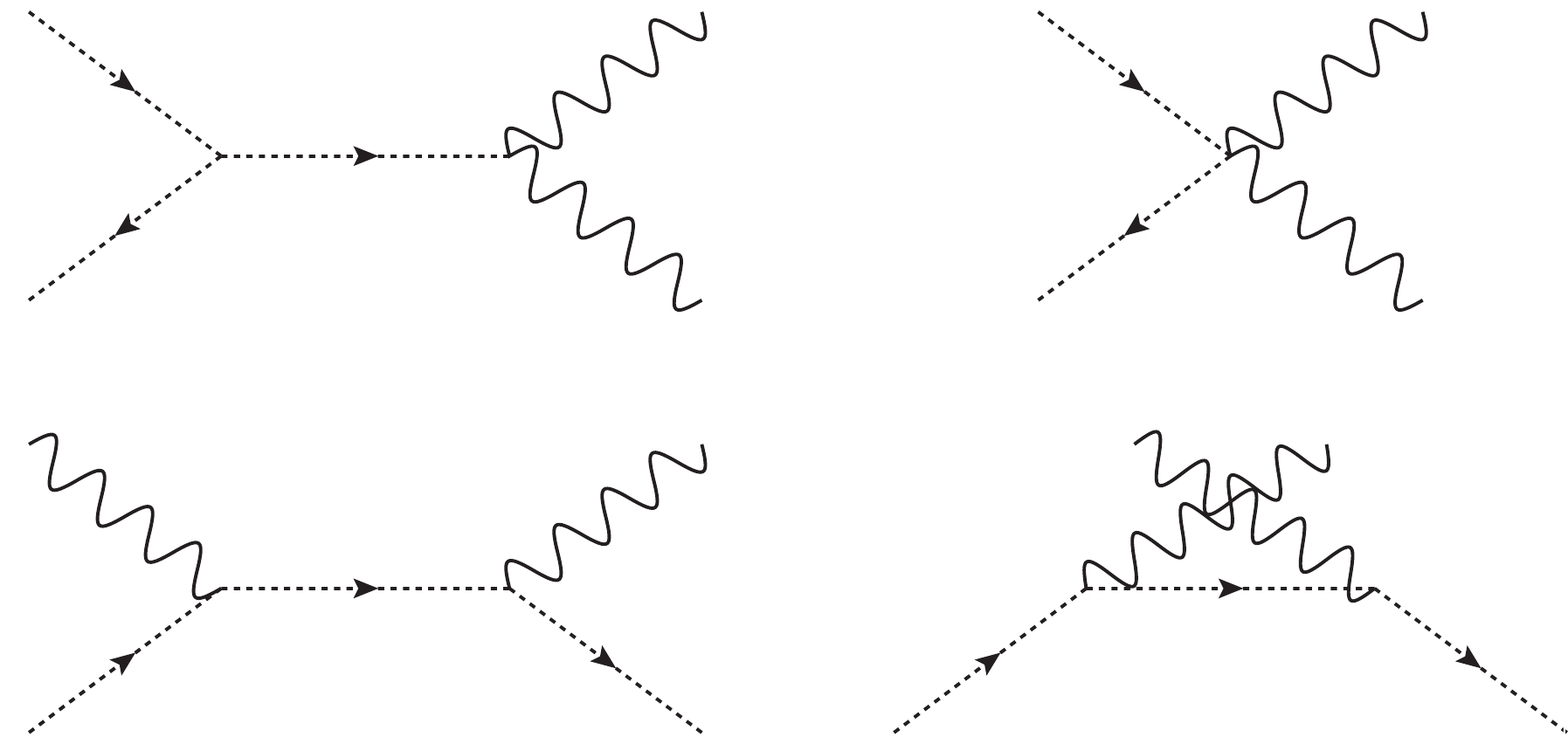 Figure2. Feynman diagrams of
Figure2. Feynman diagrams of 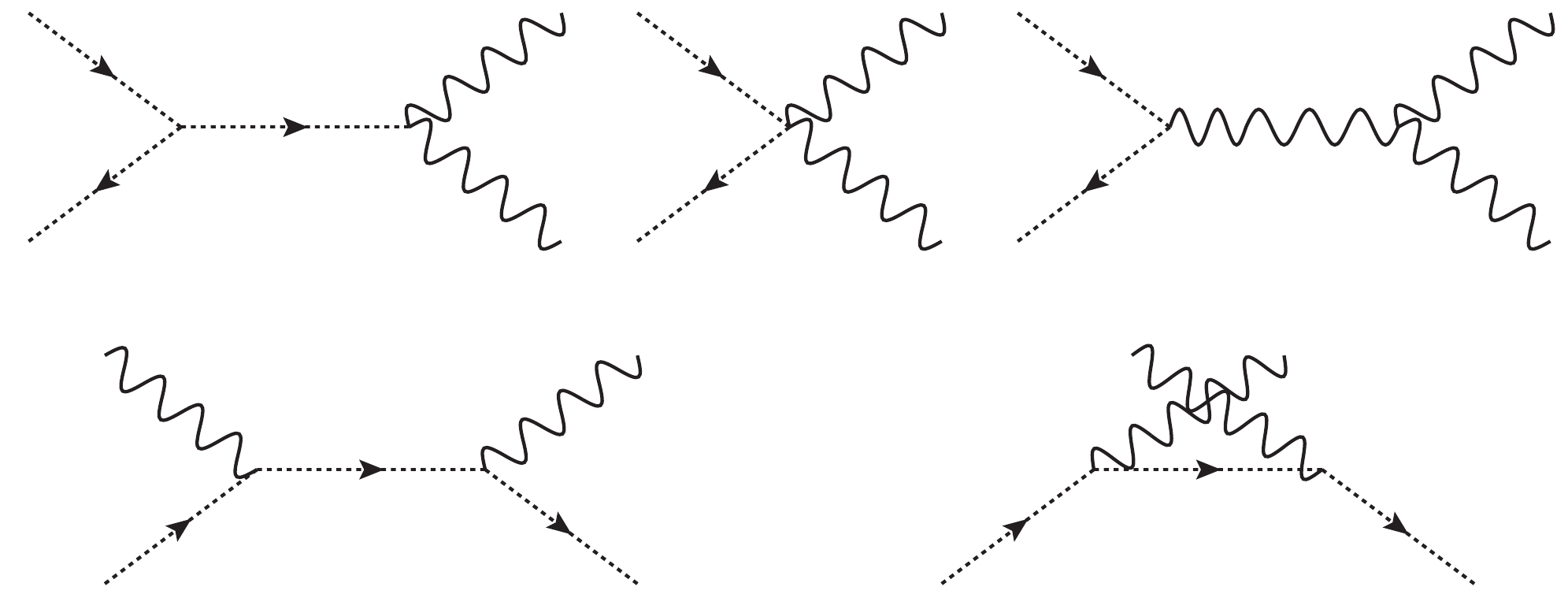 Figure3. Feynman diagrams of
Figure3. Feynman diagrams of 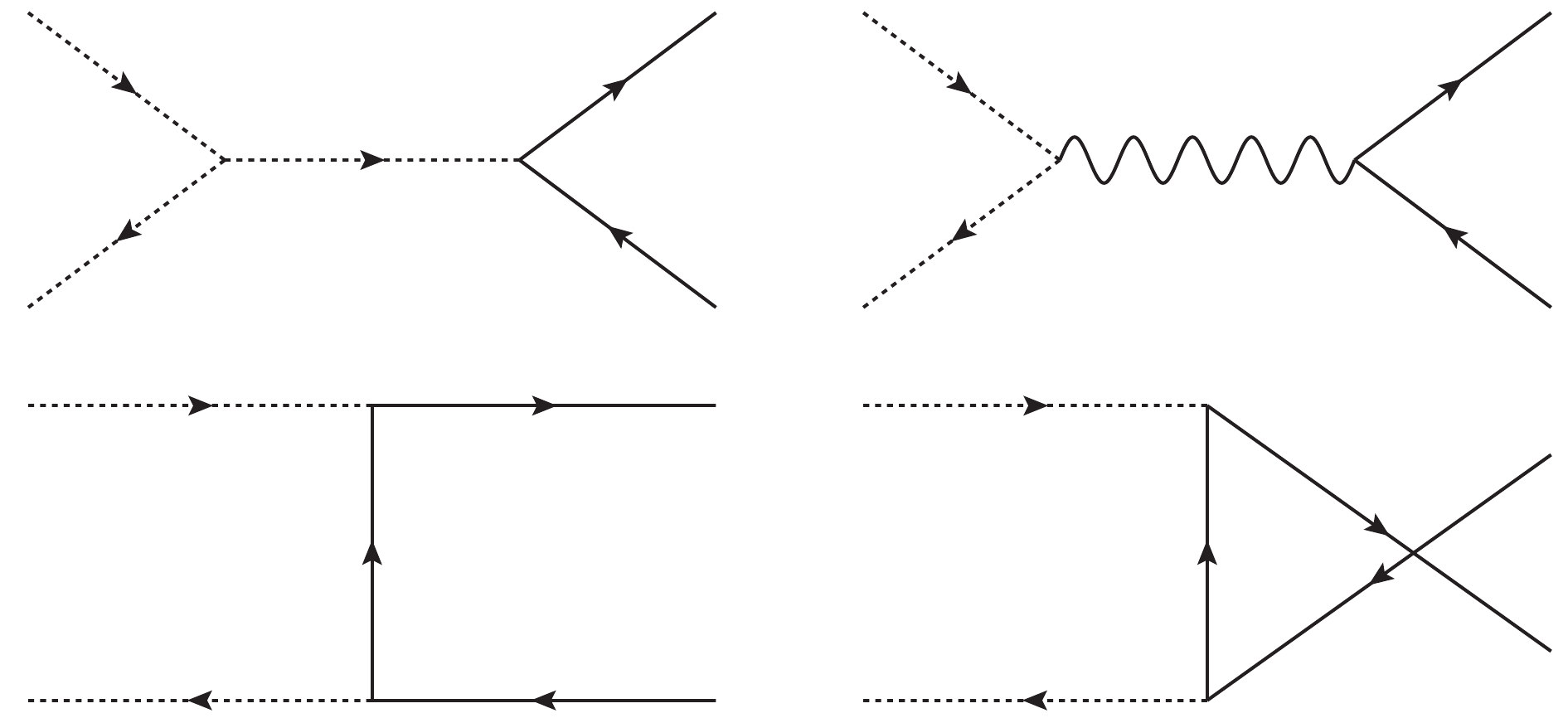 Figure4. Feynman diagrams of
Figure4. Feynman diagrams of  Figure5. Feynman diagrams of
Figure5. Feynman diagrams of The studied co-annihilation processes read as [41]
a.
b.
c.
d.
As examples, we show some results for the self-annihilation decays
$ \begin{aligned}[b]\langle{\sigma v}\rangle_{h^0 h^0} =& \frac{|M|^2}{64\pi M_{\tilde {\nu}_j}^2}\sqrt{1-\frac{m_{h^0}^2}{M_{\tilde {\nu}_j}^2}},\\ {|M|}^2 =& {|{\cal D}|}^2+{\sum\limits_{i,k = 1}^2\frac{{\cal B}_i {\cal B}_k^* {\cal C}_i {\cal C}_k^*}{(M_{\tilde {\nu}_j}^2-m_{H_i^0}^2) (M_{\tilde {\nu}_j}^2-m_{H_k^0}^2)}}\\&+2\Re\left[\sum\limits_{i = 1}^2\frac{{\cal D}^* {\cal B}_i{\cal C}_i}{(M_{\tilde {\nu}_j}^2 -m_{H_i^0}^2)}\right]. \end{aligned} $  | (18) |
$ \begin{aligned}[b]&{\cal B}_i = -\frac {e^2({A_R^{11} B_R^i +2A_R^{1i} B_R^1})}{4s_W^2 c_W^2},\quad {\cal C}_i = -\sum\limits_1^3\frac{e^2 B_R^i{Z_{I1} {Z_{I1}^*}}}{4{s_W}^2 {c_W}^2},\end{aligned} $  |
$ \begin{aligned}[b]&{\cal D} = -\frac{e^2 A_R^{11}}{4s_W^2 c_W^2} \sum\limits_{I = 1}^3{Z_{I1} Z_{I1}^*},\\& B_R^i = v_1 Z^{1i}_R-v_2 Z^{2i}_R,\\&A_R^{ij} = Z_R^{1i} Z_R^{1j}-Z_R^{2i} Z_R^{2j}.\end{aligned} $  | (19) |
The
$ \langle{\sigma v}\rangle_{\bar t t} = \frac{3(M_{\tilde \nu_j}^2-{m_t^2})}{32 \pi M_{\tilde \nu_j}^2} \frac{m^2_t}{v_u^2 }\sum\limits_{i,k = 1}^2\frac{8 {\cal C}_i {\cal C}_k^*}{(4M_{\tilde \nu_j}^2-m_{H_i^0}^2)(4M_{\tilde \nu_j}^2-{m_{H_k^0}^2})}. $  | (20) |
The cross section from virtual Z boson contribution is suppressed by
$ \begin{aligned}&a_qm_q\bar{q}q\rightarrow f_Nm_N\bar{N}N,\quad f_N = \sum\limits_{q = u,d,s}f_{Tq}^{(N)}a_q+\frac{2}{27}f_{TG}^{(N)}\sum\limits_{q = c,b,t}a_q,\\&\langle N|m_q \bar{q}q|N\rangle = m_N f_{Tq}^{(N)},\quad f_{TG}^{(N)} = 1-\sum\limits_{q = u,d,s}f_{Tq}^{(N)}.\end{aligned} $  | (21) |
$ \begin{aligned}[b] &f^{(p)}_{Tu} = 0.0153,\; \; \; f^{(p)}_{Td} = 0.0191,\; \; \; f^{(p)}_{Ts} = 0.0447, \\ &f^{(n)}_{Tu} = 0.0110,\; \; \; f^{(n)}_{Td} = 0.0273,\; \; \; f^{(n)}_{Ts} = 0.0447. \end{aligned} $  | (22) |
$ \sigma = \frac{1}{\pi}\mu_K^2[Z_pf_p+(A-Z_p)f_n]^2. $  | (23) |
The parameters used are listed in the following:
$ \begin{aligned}[b]&\tan\beta = 2,\; m_a = 1\;{\rm{TeV}}, \; AN_{11} = AN_{22} = -450\;{\rm{GeV}},\\&AN_{33} \!=\! -40\;{\rm{GeV}}, V_L \!=\! 3\;{\rm{TeV}},\; \tan\beta_L\! =\! 2,\; \lambda_{11} \!=\! \lambda_{22} \!=\! 1,\;\\&\lambda_{33} = -0.1,\; M_1 = M_2 = 1\;{\rm{TeV}}, \; \mu = 0.8\;{\rm{TeV}},\; g_L = \frac{1}{6},\;\\&ML_{11} = ML_{22} = ML_{33} = 1\;{\rm{TeV}}^2,\; \mu_L = 0.5\;{\rm{TeV}}. \end{aligned} $  | (24) |
$ \tau_{ii} = \left(M^2_{\tilde{E}}\right)_{ii},\; \; \rho_{ii} = \left(M^2_{\tilde{\nu}}\right)_{ii},\; \; \xi_{ii} = AL_{ii},\; \; \epsilon_{ii} = AL^\prime_{ii},\; (i = 1,\; 2,\; 3). $  | (25) |
At this point, the lightest scalar neutrino mass is 350 GeV, and the other scalar neutrinos' masses are all larger than 1 TeV. Additionally, the lightest scalar lepton mass is approximately 1073 GeV, and the masses of heavier scalar leptons are on the order of several TeV. The heavy CP-even Higgs mass is approximately 1 TeV. The masses of neutralinos are in the region of
We next study how these variables affect the results.
In Fig. 6, we keep the parameters
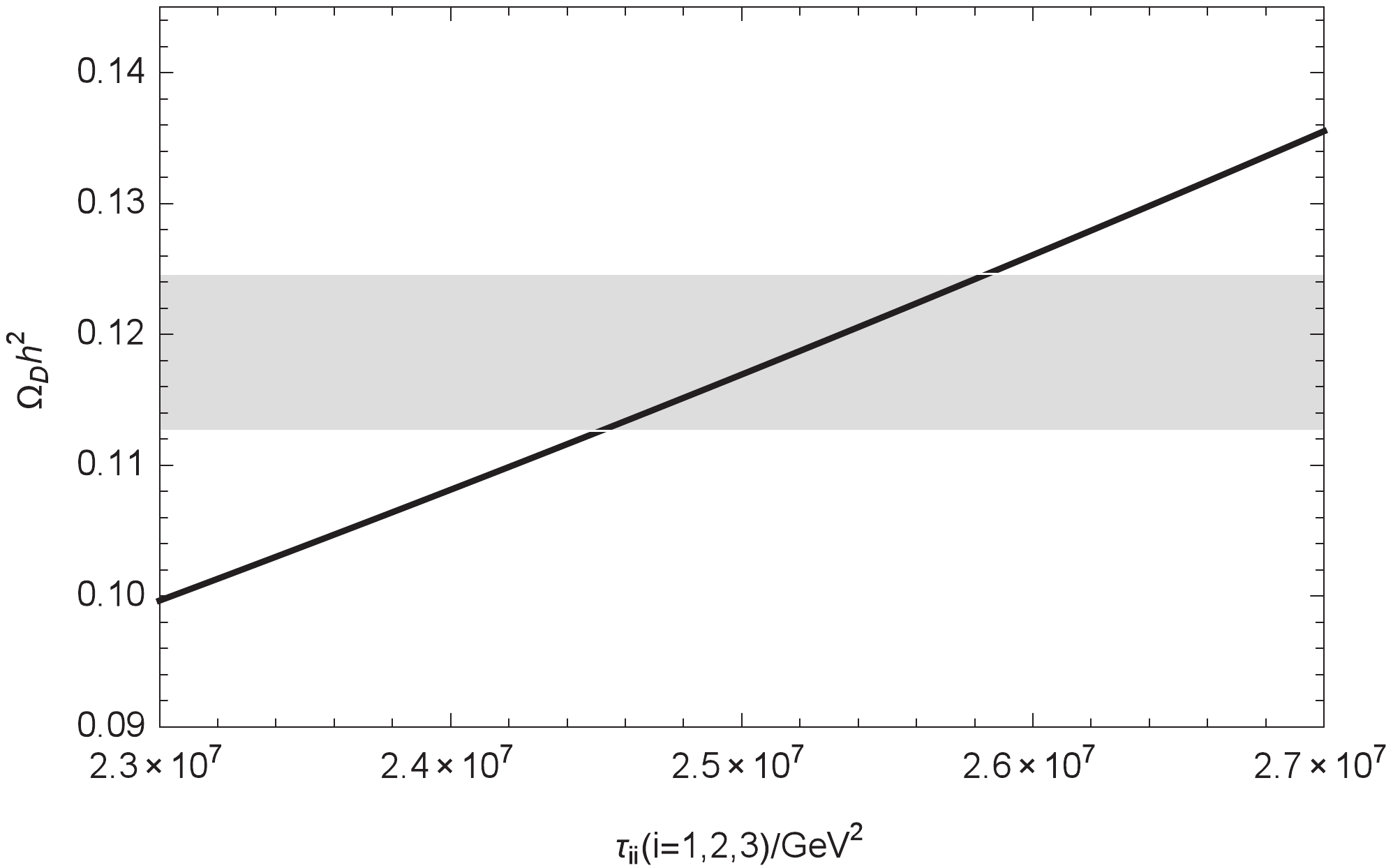 Figure6. Relationship between
Figure6. Relationship between On the contrary, Fig. 7 shows that
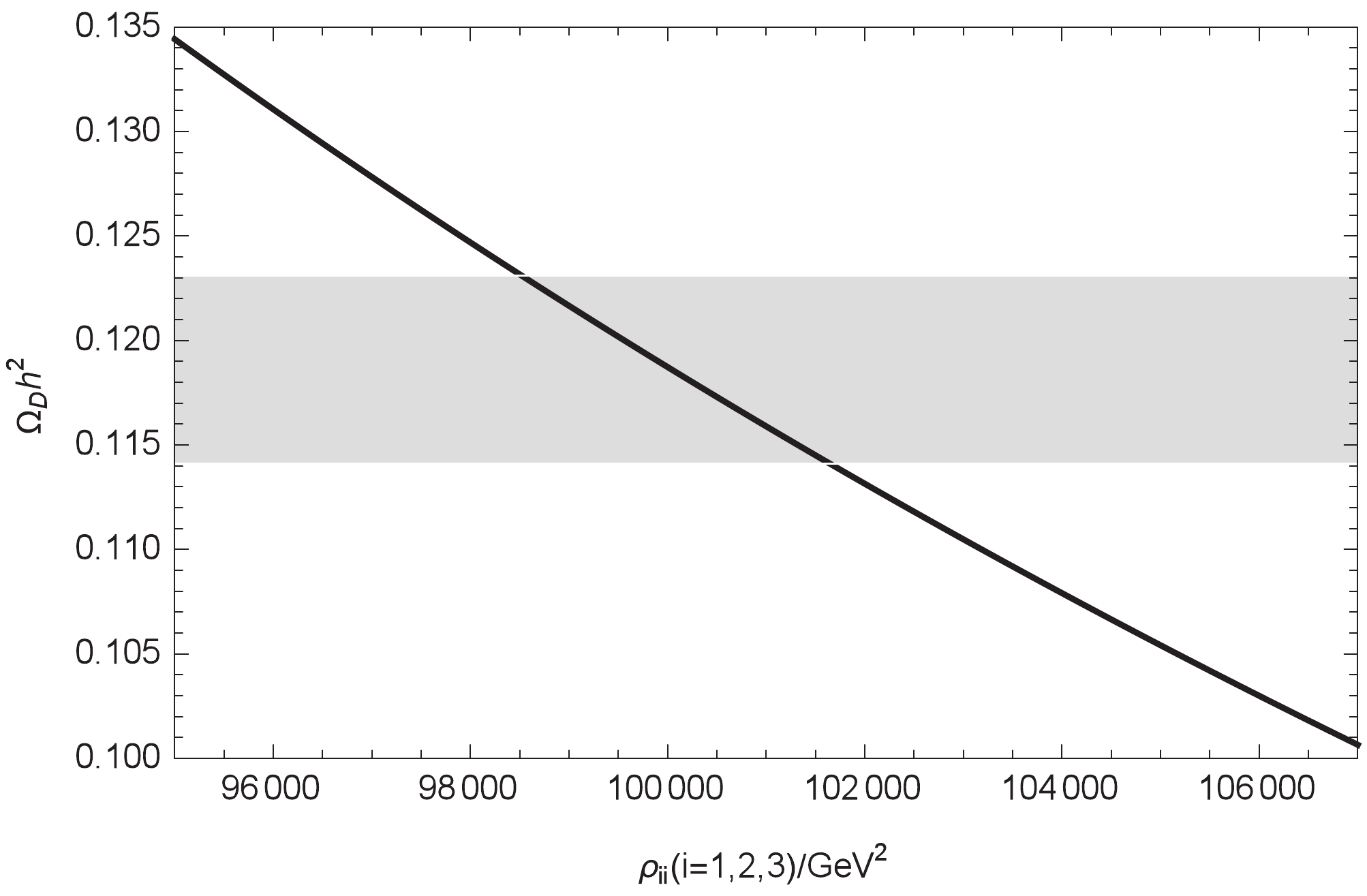 Figure7. Relationship between
Figure7. Relationship between The relationship of
 Figure8. Relationship between
Figure8. Relationship between  Figure9. Relationship between
Figure9. Relationship between With the parameters satisfying the relic density, which is shown in the first part of this section, we study the spin-independent cross section
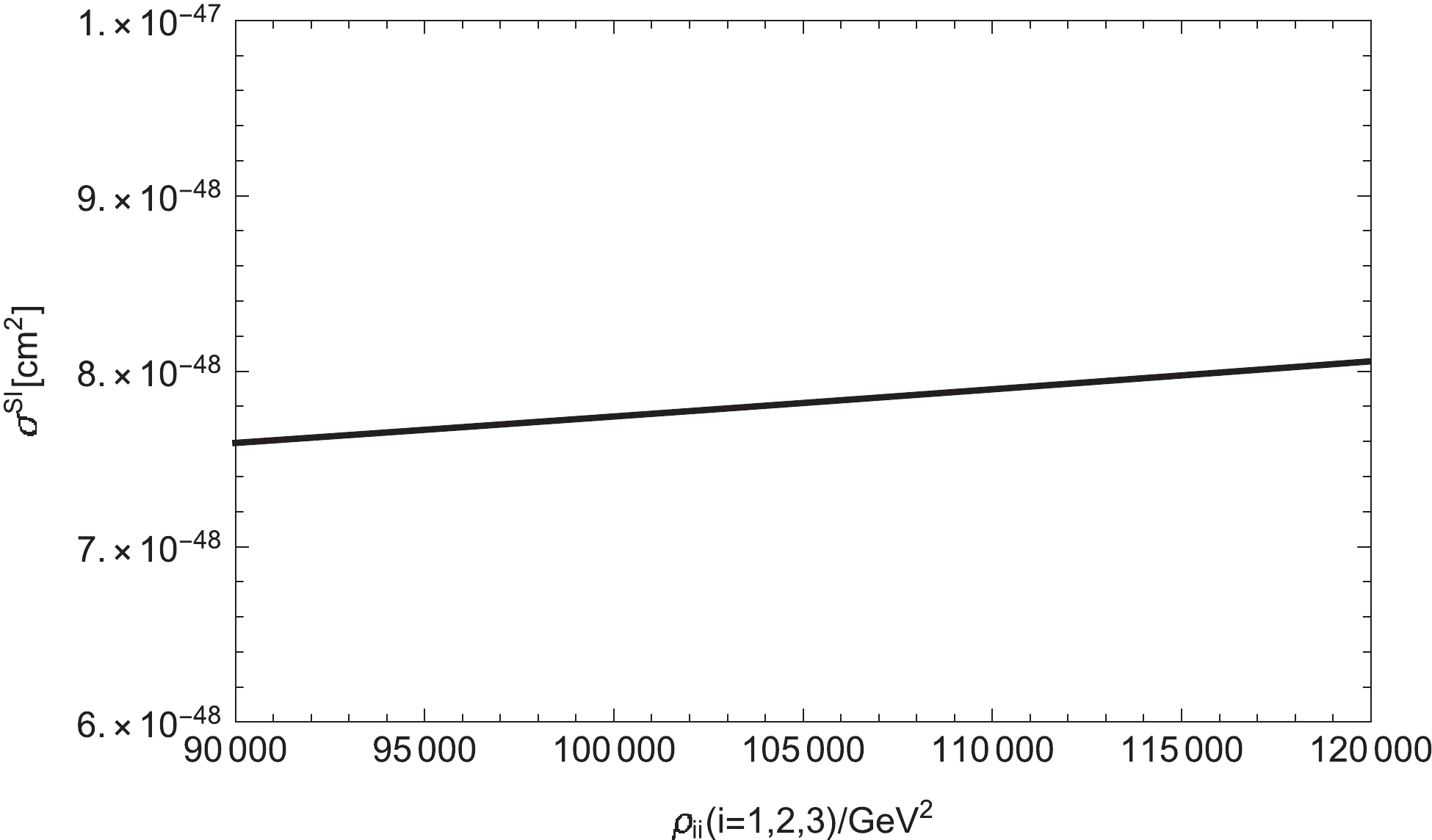 Figure10. Relationship between the spin-independent cross section and
Figure10. Relationship between the spin-independent cross section and In Fig. 11, we plot
 Figure11. Relationship between the spin-independent cross section and
Figure11. Relationship between the spin-independent cross section and Currently, theoretical physicists have proposed many models for dark matter, and the types of dark matter candidates are also enriched. In spite of this, the possibility space of reality is still much larger than our imagination. In our study, the lightest scalar neutrino could be a dark matter candidate in a reasonable range. In fact, it is one of several possibilities. Finally, we sincerely hope that researchers can uncover the real veil of dark matter as soon as possible through the full cooperation of physicists at home and abroad.

